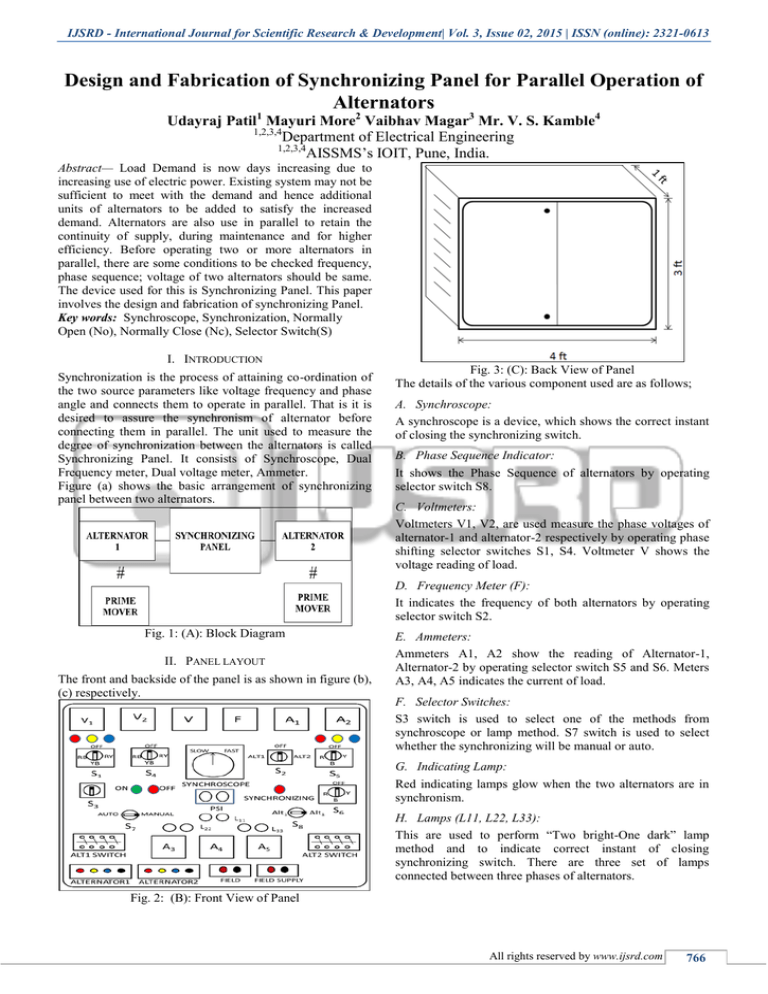
IJSRD - International Journal for Scientific Research & Development| Vol. 3, Issue 02, 2015 | ISSN (online): 2321-0613
Design and Fabrication of Synchronizing Panel for Parallel Operation of
Alternators
Udayraj Patil1 Mayuri More2 Vaibhav Magar3 Mr. V. S. Kamble4
1,2,3,4
Department of Electrical Engineering
1,2,3,4
AISSMS’s IOIT, Pune, India.
Abstract— Load Demand is now days increasing due to
increasing use of electric power. Existing system may not be
sufficient to meet with the demand and hence additional
units of alternators to be added to satisfy the increased
demand. Alternators are also use in parallel to retain the
continuity of supply, during maintenance and for higher
efficiency. Before operating two or more alternators in
parallel, there are some conditions to be checked frequency,
phase sequence; voltage of two alternators should be same.
The device used for this is Synchronizing Panel. This paper
involves the design and fabrication of synchronizing Panel.
Key words: Synchroscope, Synchronization, Normally
Open (No), Normally Close (Nc), Selector Switch(S)
I. INTRODUCTION
Synchronization is the process of attaining co-ordination of
the two source parameters like voltage frequency and phase
angle and connects them to operate in parallel. That is it is
desired to assure the synchronism of alternator before
connecting them in parallel. The unit used to measure the
degree of synchronization between the alternators is called
Synchronizing Panel. It consists of Synchroscope, Dual
Frequency meter, Dual voltage meter, Ammeter.
Figure (a) shows the basic arrangement of synchronizing
panel between two alternators.
Fig. 3: (C): Back View of Panel
The details of the various component used are as follows;
A. Synchroscope:
A synchroscope is a device, which shows the correct instant
of closing the synchronizing switch.
B. Phase Sequence Indicator:
It shows the Phase Sequence of alternators by operating
selector switch S8.
C. Voltmeters:
Voltmeters V1, V2, are used measure the phase voltages of
alternator-1 and alternator-2 respectively by operating phase
shifting selector switches S1, S4. Voltmeter V shows the
voltage reading of load.
D. Frequency Meter (F):
It indicates the frequency of both alternators by operating
selector switch S2.
Fig. 1: (A): Block Diagram
II. PANEL LAYOUT
The front and backside of the panel is as shown in figure (b),
(c) respectively.
E. Ammeters:
Ammeters A1, A2 show the reading of Alternator-1,
Alternator-2 by operating selector switch S5 and S6. Meters
A3, A4, A5 indicates the current of load.
F. Selector Switches:
S3 switch is used to select one of the methods from
synchroscope or lamp method. S7 switch is used to select
whether the synchronizing will be manual or auto.
G. Indicating Lamp:
Red indicating lamps glow when the two alternators are in
synchronism.
H. Lamps (L11, L22, L33):
This are used to perform “Two bright-One dark” lamp
method and to indicate correct instant of closing
synchronizing switch. There are three set of lamps
connected between three phases of alternators.
Fig. 2: (B): Front View of Panel
All rights reserved by www.ijsrd.com
766
Design and Fabrication of Synchronizing Panel for Parallel Operation of Alternators
(IJSRD/Vol. 3/Issue 02/2015/192)
I. Push Buttons:
Green push button (ON) is pressed when the correct instant
of synchronization is obtained. Red push button (OFF) is off
button.
III. PANEL SPECIFICATIONS
Specification of each component is given in following table,
Component
Synchroscope
Specification
110V,10A ,Analog AE
make
Phase Sequence Indicator
Two Lamps and choke
Voltmeter(Digital)
(a) 0-1000 V(2)
(b) 0-600V,AC, AE make
Frequency Meter(Digital)
50-60 Hz, AE make
Ammeter(Digital)
0-20 A, AC, AE make
Voltmeter Phase Shifting
Selector Switches
600V,4 way with OFF,
Rotary Switch
Ammeter Selector Switches
25A,4 way with OFF,
Rotary Switch
3 selector switches
16A,2way ,Rotary switch
MCB
4pole , 400V, 32A
Indicating Lamp
230V,AC
(a)Synchronizing-Red
Lamps
60W
When the alternators are synchronized, lamps 2 and
3 are bright and lamp 1 is dark. Since two of the lamps are
becoming brighter as one is dimming, it is easier to
determine the moment when the paralleling switch can be
closed. Furthermore, by observing the sequence of lamp
brightness, it is possible to tell whether the speed of the
alternator being synchronized is too slow or too fast.
B. Synchroscope:
A synchroscope is recommended for synchronizing two
alternators since it shows very accurately the exact instant of
synchronism. The pointer rotates clockwise when an
alternator is running fast and counterclockwise when an
alternator is running slow. When the pointer is stationary,
pointing upward, the alternators are synchronized.
The synchroscope is connected across one phase
only. For this reason, it cannot be used safely until the
alternators have been tested and connected together for the
proper phase rotation. Synchronizing lamps or other means
must be used to determine the phase rotation. In commercial
applications, the alternator connections to a three-phase bus
through a paralleling switch are permanent. This means that
tests for phase rotation are not necessary. As a result, a
synchroscope is the only instrument required to bring the
machines into synchronization and thus parallel them;
however, a set of lights is often used as a double-check
system.
V. PROCEDURE FOR PARALLEL OPERATION OF
ALTERNATORS USING SYNCHRONIZING PANEL
230V,AC with NO/NC
Push Button
(a)Sync ON-Green
(b)Emergency OFF-Red
3TF33 Contactor , ( 2 NO +
Power Contactor
2 NC )
Table 1: Panel Specifications
IV. SYNCHRONIZATION
There are two methods used for synchronization;
A. Synchronizing Lamps (Two bright –One dark):
A set of three synchronizing lamps are used to check the
conditions for paralleling the two alternators. In this method,
any two connections from the synchronizing lamps are
crossed after the alternators are connected and tested for the
proper phase rotation. Figure (d) shows the lamp
connections required to synchronize the alternator by the
two bright, one dark method.
Fig. 4: (D): Two Bright-One Dark Lamp Method
Fig. 5: (E): Circuit Diagram
All rights reserved by www.ijsrd.com
767
Design and Fabrication of Synchronizing Panel for Parallel Operation of Alternators
(IJSRD/Vol. 3/Issue 02/2015/192)
1) Connections are made as per the circuit diagram
2) Motor field rheostat is kept at minimum field
rheostat position.
3) Exciter field rheostat is kept in minimum field
rheostat position.
4) All the switches on synchronizing panel are kept in
OFF position.
5) Motors are started and speed is adjusted to rated
value(1500 r.p.m)
6) Alternator-1and alternator-2 switch is made ON.
7) The selector switch is made on manual mode.
8) The voltage, phase sequence and frequency of two
alternators is observed on respective panels by
operating respective switches.
9) Selector switch is kept on lamp method position
and the lamps are observed carefully.
10) The correct instant of synchronization is one pair of
lamp dark and remaining two pairs of lamp equally
bright.
11) Flickering of bulbs should be minimum. If it is not
minimum, the speed of any one alternator is
slightly adjusted until flickering is minimum.
12) After detecting correct instant of synchronization,
the ON push button of panel is pressed and the
alternators are now synchronized. This reading is
noted down.(No load condition)
13) The load switch is now made ON so load is
connected to two alternators and the load is
adjusted to form a balanced load condition.
14) Load is gradually increased and corresponding
observations are noted.
15) Load is made off.
16) Load switch is opened stop push button panel is
pressed.
17) Alternator excitation is brought to minimum DC
motor supply is switched off.
18) The similar procedure is adopted for synchronism
of alternators using synchroscope method. The
synchroscope is observed during adjustments.
When pointer of synchroscope moves very slowly
and coincides with synchronization MARK on the
dial, the ON push button of panel is pressed. Thus,
alternators are synchronized.
REFERENCES
[1] Michael J. Thompson, “Fundamentals and
Advancements in Generator Synchronizing
Systems” Schweitzer Engineering Laboratories,
Inc.
[2] W. M. Strang, C. J. Mozina, B. Beckwith, T. R.
Beckwith, S. Chhak, E. C. Fennell, E. W.
Kalkstein, K. C. Kozminski, A. C. Pierce, P. W.
Powell, D. W. Smaha, J. T. Uchiyama, S. M.
Usman, and W. P. Waudby, “Generator
Synchronizing Industry Survey Results,”IEEE
Transactions on Power Delivery, Vol. 11, Issue 1,
pp. 174–183,Jan. 1996.
VI. CONCLUSION
In this paper, Synchronizing panel has been successfully
designed that should prove very useful for parallel operation
of alternators. Based on pretest done without panel and
evaluations, we believe the use of synchronizing panel gives
better result.
Synchronous generators must be connected to the
power system only when the slip (speed difference), voltage
difference, and angle difference are within acceptable
parameters. Synchronizing systems include controls to
adjust the frequency and voltage of the incoming generator
to the running bus and instrumentation to allow operators to
monitor the critical synchronizing measurements to
determine when to close the breaker.
All rights reserved by www.ijsrd.com
768

